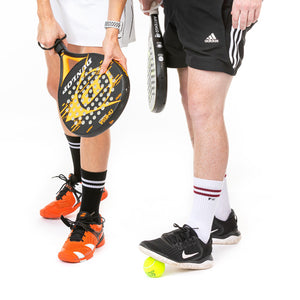THE PADEL FOOT, DOES IT EXIST?
Padel is a very popular sport among both men and women, children and adults. The sport is a mix between tennis, squash and badminton. The fact that it has become so popular is due to the fact that it is easy to get started and create a fun ball game even for beginners, and that no direct equipment is required.
Common injuries in padel
Common injuries when playing padel are foot, ankle and knee injuries as well as wrist and elbow injuries. It is above all rapid accelerations and heavy braking, sideways movements, missteps, and unilateral movements that cause the body to take damage.
We will look a little more at which foot injuries occur in padel and how you can prevent and treat them.
Prevent ruptures in the calf muscles with heating and calf support
Padel is known for its high tempo of play with strong accelerations and abrupt decelerations. This means that the calf muscles are heavily loaded and ruptures in the calf muscles and the lower leg muscles can occur. This usually happens when you reach for a set piece, or jump up to smash. In most cases, you will recognize a rupture by the fact that it stabs in the calf, after which the leg becomes numb and the pain comes.
You can easily avoid strains and sprains by warming up properly before you start playing. Here you can read more about ruptures in the calf muscles, which also go by the name old man calves.
Support around the ankle can reduce injuries in case of missteps
Anyone who has taken a padel lesson knows how important footwork is. Sprains and strains usually occur when you step sideways when reaching for a ball. By stabilizing the ankle, you also prevent damage that can occur when stepping on the wrong foot. This can be done with ankle supports or compression stockings .
Socks for heel spurs
Getting heel spurs is very common in padel. A heel spur is a build-up (calcium spur) that forms where the hallux valgus tendon attaches to the heel. It can occur with long-term overloading of the hallux valgus tendon. The treatment for heel spurs is rest, better shoes, stretching and shock wave therapy.
To reduce the heavy load on the heel, it is important that you choose the right shoes and socks. Shoes with cushioning provide a smaller load. Socks with cushioning around the heel can also provide a smoother step and prevent heel spurs.
Recovery and rest
Padel takes a lot of wear and tear on the body, especially if you are untrained and in pure enthusiasm play a little too many times a week. It is important for the body to rest and recover between training sessions. Compression stockings increase blood circulation, which in turn counteracts pain and wear and tear in the calf muscles.
Tips to avoid injuries in Padel
- Warm up – a good protection against stretching and tearing
- Stretch - make sure to keep the body mobile and flexible
- Recovery – give the body time to rest and recover
- Do strength training regularly - give the body the best conditions to handle oblique strain
- Support - stabilize calf muscles, ankles and hard steps with supportive protection

